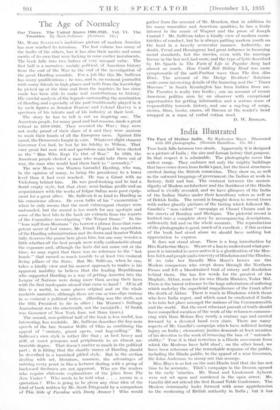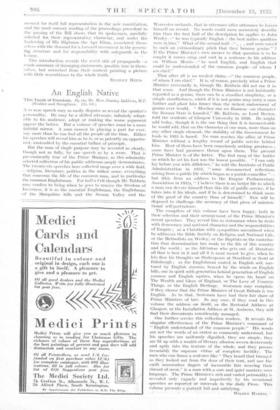India Illustrated
Tuts book falls between two. stools. Apparently it is designed as a picture of India ; the size and format betray that purpose. In that respect it is admirable. The photographs cover the widest range. They embrace not only the mighty buildings that have come down from India's past, but the finest structures erected during the British connexion. They show us, as well as the outward trappings of government, the Indian at work in factory, field and hut. The contrast between the austere dignity of Moslem architecture and the floridness of the Hindu school is vividly revealed, and we have glimpses of the India of the Indian States under their hereditary rulers as well as of British India. The record is brought down to recent times with rather ghastly pictures of the 'rioting which followed Mr. Gandhi's " non-violent " campaign at Chauri Chaura and in the streets of Bombay and Sholapur. The pictorial record is knitted into a complete story by accompanying descriptions, sufficiently full and on the whole accurate. ' The reproduction of the photographs is good, much.of it excellent ; if this section of the book had stood alone we should have nothing but appreciation to express.
It does not stand alone. There is a long introduction by Miss Katherine Mayo. • We are at a loss to understand what pur- pose it is intended to serve unless it is a glorification of the Mos- lem faith and people and a travesty of Hinduism and the Hindus. If we take her literally Miss Mayo's heroes are the Moslem conquerors who swept down ' through the Northern Passes and left a bloodstained trail of misery and desolation behind them. • She has few words for the greatest of ' the Mughals, Akbar, none for his wise Hindu Minister, Todar Mal. There is the barest reference to the huge substratum of suffering which underlay the superficial magnificence of the Court, after the death of Akbar. There is much in Hinduism which those who love India regret, and which must be eradicated if India is to take her place amongst the nations of the Commonwealth and the world. But the most reluctant pursuit of truth should have compelled mention of the work of the reformers commen- cing with Ram Mohun Roy nearly a century ago and carried forward by a devoted band ever since. There arc many aspects of Mr. Gandhi's campaign which have inflicted lasting injury on India ; elementary justice demands at least mention of his devotion to the work of removing the ban of " untouch- ability." True it is that terrorism is a Hindu movement from which the Moslems have held aloof ; on the other hand, we have been witnesses of the retnarkable response of the public, including the Hindu public, to the appeal of a wise Governor, Sir John Anderson, to stamp out this scourge.
Miss. Mayo is so hot on the anti-Hindu trail that she has not time to be accurate. Tilak's campaign in the Deccan opened in the early 'nineties. Mr. Hand and Lieutenant Ayherst were not set upon and murdered in the open street. Mr. Gandhi did not attend the first Round Table Conference. The Moslem community looks forward with some apprehension to the weakening of British authority in India ; but it has secured for itself full representation in the neW constitution, and the most cursory reading of the proceedings precedent to the passing of the Bfil shows that its spokesmen, aarefull- seks•ted for, their retwesentative:tharaeter,_ and under the leadership of His Highness the Aga Khan, associated them- selves with the demand for a forward movement, in the govern- ing structure and for responsibility with safeguards in the Cent re.
This introduction reveals the worst side of propaganda--a crude summary of damaging statements, possibly true in them- selves, but wrenched from their context painting a picture with little resemblance to the whole truth.
. STANLEY REED.















































 Previous page
Previous page